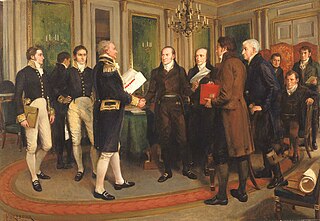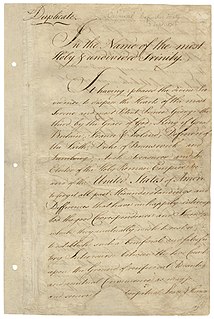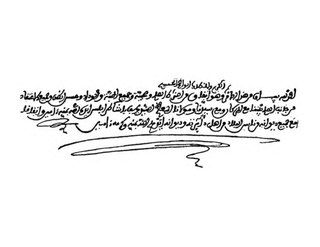Related Research Articles

The Treaty of Ghent was the peace treaty that ended the War of 1812 between the United States and the United Kingdom. It took effect in February 1815. Both sides signed it on December 24, 1814, in the city of Ghent, United Netherlands. The treaty restored relations between the two parties to status quo ante bellum by restoring the pre-war borders of June 1812.

The Treaty of Paris, signed in Paris by representatives of King George III of Great Britain and representatives of the United States of America on September 3, 1783, officially ended the American Revolutionary War and overall state of conflict between the two countries. The treaty set the boundaries between the British Empire in North America and the United States of America, on lines "exceedingly generous" to the latter. Details included fishing rights and restoration of property and prisoners of war.

The Atlantic Charter was a statement issued on 14 August 1941 that set out American and British goals for the world after the end of World War II. The joint statement, later dubbed the Atlantic Charter, outlined the aims of the United States and the United Kingdom for the postwar world as follows: no territorial aggrandizement, no territorial changes made against the wishes of the people (self-determination), restoration of self-government to those deprived of it, reduction of trade restrictions, global co-operation to secure better economic and social conditions for all, freedom from fear and want, freedom of the seas, abandonment of the use of force, and disarmament of aggressor nations. The charter's adherents signed the Declaration by United Nations on 1 January 1943, which was the basis for the modern United Nations.

The Treaty of Tripoli was signed in 1796. It was the first treaty between the United States and Tripoli to secure commercial shipping rights and protect American ships in the Mediterranean Sea from local Barbary pirates.

The Province of Georgia was one of the Southern colonies in British America. It was the last of the thirteen original American colonies established by Great Britain in what later became the United States. In the original grant, a narrow strip of the province extended to the Pacific Ocean.

The Founding Fathers of the United States, or simply the Founding Fathers or Founders, were a group of late-18th century American revolutionary leaders who united the Thirteen Colonies, led the war for independence from Great Britain, and crafted a framework of government for the new United States nation.
The Charter of the International Military Tribunal – Annex to the Agreement for the prosecution and punishment of the major war criminals of the European Axis was the decree issued by the European Advisory Commission on 8 August 1945 that set down the rules and procedures by which the Nuremberg trials were to be conducted. This then served as a model for the Tokyo Charter issued months later against the Empire of Japan.

Federalist No. 13 is an essay by Alexander Hamilton, the thirteenth of The Federalist Papers. It was published on November 28, 1787, under the pseudonym Publius, the name under which all The Federalist papers were published. It is titled "Advantage of the Union in Respect to Economy in Government".

Federalist No. 24 is an essay by Alexander Hamilton, the twenty-fourth of The Federalist Papers. It was published on December 19, 1787, under the pseudonym Publius, the name under which all The Federalist papers were published. It is titled "The Powers Necessary to the Common Defense Further Considered".

Federalist No. 25 is an essay by Alexander Hamilton, the twenty-fifth of The Federalist Papers. It was published on December 21, 1787, under the pseudonym Publius, the name under which all The Federalist papers were published. It continues the discussion begun in Federalist No. 24. No. 25 is titled "The Same Subject Continued: The Powers Necessary to the Common Defense Further Considered".

German-occupied Poland during World War II consisted of two major parts with different types of administration.
The Treaty of Bern, signed on 9 October 1874, established the General Postal Union, which is today known as the Universal Postal Union. Named for the Swiss city of Bern, where it was signed, the treaty was the result of an international conference convened by the Swiss Government on 15 September 1874. It was attended by representatives of 22 nations. Plans for the conference had been drawn up by Heinrich von Stephan, Postmaster-General of the German Reichspost who demanded from the neutral Switzerland the organization of an International Postal Congress following the end of the French-German war of 1870–1871.

The Lillian Goldman Law Library in Memory of Sol Goldman, commonly known as the Yale Law Library, is the law library of Yale Law School. It is located in the Sterling Law Building and has almost 800,000 volumes of print materials and about 10,000 active serial titles, in which there are 200,000 volumes of foreign and international law materials. The library was named after a US$20 million donation made by Lillian Goldman, widow of real estate magnate Sol Goldman.
Originally, the state of New Jersey was a single British colony, the Province of New Jersey. After the English Civil War, Charles II assigned New Jersey as a proprietary colony to be held jointly by Sir George Carteret and John Berkeley, 1st Baron Berkeley of Stratton. Eventually, the collection of land fees, or quit-rents, from colonists proved inadequate for colonial profitability. Sir George Carteret sold his share of the colony to the Quakers in 1673. Following the sale, the land was divided into East and West Jersey. In 1681, West Jersey adopted a constitution. In 1683, East Jersey adopted one as well. In 1702, the colonies were united again under Anne, Queen of Great Britain, and adopted a constitution in 1776.

In the United States the right to petition is enumerated in the First Amendment to the United States Constitution, which specifically prohibits Congress from abridging "the right of the people peaceably to assemble, and to petition the Government for a redress of grievances".

The drafting of the Constitution of the United States began on May 25, 1787, when the Constitutional Convention met for the first time with a quorum at the Pennsylvania State House in Philadelphia, Pennsylvania to revise the Articles of Confederation. It ended on September 17, 1787, the day the Frame of Government drafted by the convention's delegates to replace the Articles was adopted and signed. The ratification process for the Constitution began that day, and ended when the final state, Rhode Island, ratified it on May 29, 1790.

The Congressional Apportionment Amendment is a proposed amendment to the United States Constitution that addresses the number of seats in the House of Representatives. It was proposed by Congress on September 25, 1789, but was never ratified by the requisite number of state legislatures. As Congress did not set a time limit for its ratification, the Congressional Apportionment Amendment is still pending before the states. As of 2022, it is one of six unratified amendments.

The first inauguration of Richard Nixon as the 37th president of the United States was held on Monday, January 20, 1969, at the East Portico of the United States Capitol in Washington, D.C. This was the 46th inauguration and marked the commencement of the first and eventually only full term of both Richard Nixon as president and Spiro Agnew as vice president. Chief Justice Earl Warren administered the presidential oath of office to Nixon, and Senate Minority Leader Everett Dirksen administered the vice presidential oath to Agnew. Nixon was the first non-incumbent vice president to be inaugurated as president. This was also the last presidential oath administered by Chief Justice Warren.

The Treaty of Tuscaloosa was signed in October, 1818, and ratified by congress in January 1819. It was one of a series of treaties made between the Chickasaw Indians and the United States that year. The Treaty of Tuscaloosa was represented by Senator Andrew Jackson and ex-governor Isaac Shelby to the Chickasaw. It resulted in the acquisition of the Jackson Purchase.
References
- ↑ "Avalon Project: Documents in Law, History and Diplomacy". Center for History and New Media. George Mason University.
- ↑ "Statement of Purpose". Yale Law School: Lillian Goldman Law Library. Archived from the original on June 2, 2022. Retrieved September 6, 2022.
- ↑ "The Avalon Project: Documents in Law, History and Diplomacy". Yale Law School Lillian Goldman Law Library. Archived from the original on March 11, 2022. Retrieved September 6, 2022.